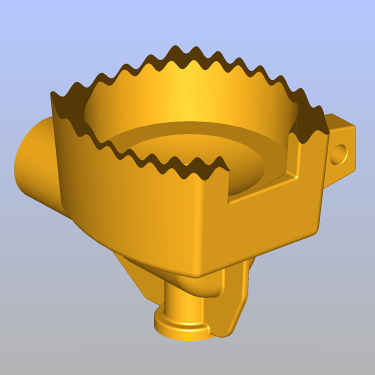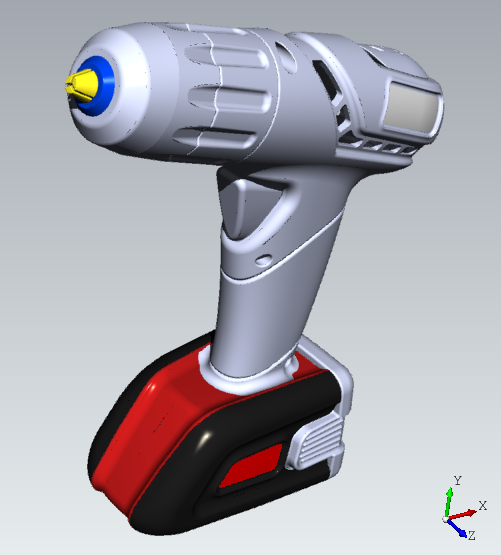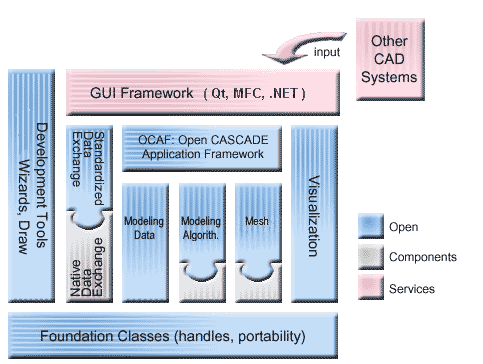Open CASCADE Technology (OCCT) is an object-oriented C++ class library designed for rapid production of sophisticated domain-specific CAD/CAM/CAE applications.
A typical application developed using OCCT deals with two or three-dimensional (2D or 3D) geometric modeling in general-purpose or specialized Computer Aided Design (CAD) systems, manufacturing or analysis applications, simulation applications, or even illustration tools.
OCCT library is designed to be truly modular and extensible, providing C++ classes for:
- Basic data structures (geometric modeling, visualization, interactive selection and application specific services);
- Modeling algorithms;
- Working with mesh (faceted) data;
- Data interoperability with neutral formats (IGES, STEP);
The C++ classes and other types are grouped into packages. Packages are organized into toolkits (libraries), to which you can link your application. Finally, toolkits are grouped into seven modules.
This modular structure is illustrated in the diagram below.
- Foundation Classes module underlies all other OCCT classes;
- Modeling Data module supplies data structures to represent 2D and 3D geometric primitives and their compositions into CAD models;
- Modeling Algorithms module contains a vast range of geometrical and topological algorithms;
- Mesh module implements tessellated representations of objects;
- Visualization module provides complex mechanisms for graphical data representation;
- Data Exchange module inter-operates with popular data formats and relies on Shape Healing to improve compatibility between CAD software of different vendors;
- Application Framework module offers ready-to-use solutions for handling application-specific data (user attributes) and commonly used functionality (save/restore, undo/redo, copy/paste, tracking CAD modifications, etc).
In addition, Open CASCADE Test Harness, also called Draw, provides an entry point to the library and can be used as a testing tool for its modules.
Foundation Classes
Foundation Classes module contains data structures and services used by higher-level Open CASCADE Technology classes:
- Primitive types, such as Boolean, Character, Integer or Real;
- String classes that handle ASCII and Unicode strings;
- Collection classes that handle statically or dynamically sized aggregates of data, such as arrays, lists, queues, sets and hash tables (data maps).
- Classes providing commonly used numerical algorithms and basic linear algebra calculations (addition, multiplication, transposition of vectors and matrices, solving linear systems etc).
- Fundamental types representing physical quantities and supporting date and time information;
- Primitive geometry types providing implementation of basic geometric and algebraic entities that define and manipulate elementary data structures.
- Exception classes that describe situations, when the normal execution of program is abandoned;
This module also provides a variety of general-purpose services, such as:
- Safe handling of dynamically created objects, ensuring automatic deletion of unreferenced objects (smart pointers);
- Configurable optimized memory manager increasing the performance of applications that intensively use dynamically created objects;
- Extended run-time type information (RTTI) mechanism maintaining a full type hierarchy and providing means to iterate over it;
- Encapsulation of C++ streams;
- Automated management of heap memory by means of specific allocators;
- Basic interpreter of expressions facilitating the creation of customized scripting tools, generic definition of expressions, etc.;
- Tools for dealing with configuration resource files and customizable message files facilitating multi-language support in applications;
- Progress indication and user break interfaces, giving a possibility even for low-level algorithms to communicate with the user in a universal and convenient way;
- and many others...
See the details in Foundation Classes User's Guide
See also: our E-learning & Training offerings.
Modeling Data
Modeling Data supplies data structures to implement boundary representation (BRep) of objects in 3D. In BRep the shape is represented as an aggregation of geometry within topology. The geometry is understood as a mathematical description of a shape, e.g. as curves and surfaces (simple or canonical, Bezier, NURBS, etc). The topology is a data structure binding geometrical objects together.
Geometry types and utilities provide geometric data structures and services for:
- Description of points, vectors, curves and surfaces:
- their positioning in 3D space using axis or coordinate systems, and
- their geometric transformation, by applying translations, rotations, symmetries, scaling transformations and combinations thereof.
- Creation of parametric curves and surfaces by interpolation and approximation;
- Algorithms of direct construction;
- Conversion of curves and surfaces to NURBS form;
- Computation of point coordinates on 2D and 3D curves;
- Calculation of extrema between geometric objects.
Topology defines relationships between simple geometric entities. A shape, which is a basic topological entity, can be divided into components (sub-shapes):
- Vertex – a zero-dimensional shape corresponding to a point;
- Edge – a shape corresponding to a curve and bounded by a vertex at each extremity;
- Wire – a sequence of edges connected by their vertices;
- Face – a part of a plane (in 2D) or a surface (in 3D) bounded by wires;
- Shell – a collection of faces connected by edges of their wire boundaries;
- Solid – a finite closed part of 3D space bounded by shells;
- Compound solid – a collection of solids connected by faces of their shell boundaries.
Complex shapes can be defined as assemblies of simpler entities.
See the details in Modeling Data User's Guide
3D geometric models can be stored in OCCT native BREP format. See BREP Format Description White Paper for details on the format.
See also: our E-learning & Training offerings.
Modeling Algorithms
Modeling Algorithms module groups a wide range of topological and geometric algorithms used in geometric modeling. Basically, there are two groups of algorithms in Open CASCADE Technology:
- High-level modeling routines used in the real design;
- Low-level mathematical support functions used as a groundwork for the modeling API;
- Low-level geometric tools provide the algorithms, which:
- Calculate the intersection of two curves, surfaces, or a curve and a surface;
- Project points onto 2D and 3D curves, points onto surfaces and 3D curves onto surfaces;
- Construct lines and circles from constraints;
- Construct free-form curves and surfaces from constraints (interpolation, approximation, skinning, gap filling, etc);
- Low-level topological tools provide the algorithms, which:
- Tessellate shapes;
- Check correct definition of shapes;
- Determine the local and global properties of shapes (derivatives, mass-inertia properties, etc);
- Perform affine transformations;
- Find planes in which edges are located;
- Convert shapes to NURBS geometry;
- Sew connected topologies (shells and wires) from separate topological elements (faces and edges).
Top-level API provides the following functionality:
- Construction of Primitives:
- Boxes;
- Prisms;
- Cylinders;
- Cones;
- Spheres;
- Toruses.
- Kinematic Modeling:
- Prisms – linear sweeps;
- Revolutions – rotational sweeps;
- Pipes – general-form sweeps;
- Lofting.

Shapes containing pipes with variable radius produced by sweeping
- Boolean Operations, which allow creating new shapes from the combinations of source shapes. For two shapes S1 and S2:
- Common contains all points that are in S1 and S2;
- Fuse contains all points that are in S1 or S2;
- Cut contains all points in that are in S1 and not in S2
See Boolean Operations User's Guide for detailed documentation.
- Algorithms for local modifications such as:
- Hollowing;
- Shelling;
- Creation of tapered shapes using draft angles;
- Algorithms to make fillets and chamfers on shape edges, including those with variable radius (chord).
- Algorithms for creation of mechanical features, i.e. depressions, protrusions, ribs and grooves or slots along planar or revolution surfaces.
See the details in Modeling Algorithms User's Guide.
See also: our E-learning & Training offerings.
Mesh
Mesh module provides the functionality to work with tessellated representations of objects in form of triangular facets. This module contains:
- data structures to store surface mesh data associated to shapes and basic algorithms to handle them;
- data structures and algorithms to a build triangular surface mesh from BRep objects (shapes);
- tools for displaying meshes with associated pre- and post-processor data (scalars or vectors).
Open CASCADE Technology includes two mesh converters:
- VRML converter translates Open CASCADE shapes to VRML 1.0 files (Virtual Reality Modeling Language). Two representation modes are possible: shaded, which presents shapes as sets of triangles computed by the mesh algorithm, or wireframe, which presents shapes as sets of curves.
- STL converter translates Open CASCADE shapes to STL files. STL (STtereoLithography) format is widely used for rapid prototyping (3D printing).
Open CASCADE SAS also offers Advanced Mesh Products:
Visualization
Visualization module provides ready-to-use algorithms to create graphic presentations from various objects: shapes, meshes, etc.
In Open CASCADE Technology visualization is based on the separation of CAD data and its graphical presentation. The presentations can be customized to take the specificity of your application into account.
The module also supports a fast and powerful interactive selection mechanism.
The view facilities provided by OCCT range from low-level tools working with basic geometry and topology (such as NURBS visualization with control points and nodes, rendering of isolines to estimate speed and quality of parameterization, or rendering of a parametric profile of edges) to high-level tools for real time quality rendering of models using ray tracing: shades, reflections, transparency, anti-aliasing, etc.
Here are just a few examples:
- Camera-driven view projection and orientation. It is possible to choose between perspective, orthographic and stereographic projection.
- Real-time ray tracing technique using recursive Whitted's algorithm and Bounded Volume Hierarchy effective optimization structure.

Real time visualization by ray tracing method
- Support of GLSL shaders. The shader management is fully automatic, like with any other OpenGL resource.

Fragment shader implementing custom clipping surface
- Support of standard and custom materials, defined by transparency, diffuse, ambient and specular reflection and refraction index. The latter allows implementing transparent materials, such as glass, diamond and water.

Simulation of a glass cover
- Optimization of rendering performance through the algorithms of:
- View frustum culling, which skips the presentation outside camera at the rendering stage and
- Back face culling, which reduces the rendered number of triangles and eliminates artifacts at shape boundaries.
- Definition of clipping planes through the plane equation coefficients. Ability to define visual attributes for cross-section at the level or individual clipping planes. In the image below different parts of the rocket are clipped with different planes and hatched.
- Possibility to flexibly adjust appearance of dimensions in a 3D view. The 3D text object represents a given text string as a true 3D object in the model space.

Display of shape cross-section and dimensions
For more details, see Visualization User's Guide.
The visualization of OCCT topological shapes by means of VTK library provided by VIS component is described in a separate VTK Integration Services User's Guide.
See also: our E-learning & Training offerings.
Data Exchange
Data Exchange allows developing OCCT-based applications that can interact with other CAD systems by writing and reading CAD models to and from external data. The exchanges run smoothly regardless of the quality of external data or requirements to its internal representation, for example, to the data types, accepted geometric inaccuracies, etc.

Shape imported from STEP
Data Exchange is organized in a modular way as a set of interfaces that comply with various CAD formats: IGES, STEP, STL, VRML, etc. The interfaces allow software based on OCCT to exchange data with various CAD/PDM software packages, maintaining a good level of interoperability.
- Standardized Data Exchange interfaces allow querying and examining the input file, converting its contents to a CAD model and running validity checks on a fully translated shape. The following formats are currently supported.
- STEP (AP203 : Mechanical Design, this covers General 3D CAD; AP214: Automotive Design)
- IGES (up to 5.3)
- glTF, OBJ, VRML and STL meshes.
- Extended data exchange (XDE) allows translating additional attributes attached to geometric data (colors, layers, names, materials etc).
- Advanced Data Exchange Components are available in addition to standard Data Exchange interfaces to support interoperability and data adaptation (also using Shape Healing) with CAD software using the following proprietary formats:
These components are based on the same architecture as interfaces with STEP and IGES.
Shape Healing
Shape Healing library provides algorithms to correct and adapt the geometry and topology of shapes imported to OCCT from other CAD systems.
Shape Healing algorithms include, but are not limited to, the following operations:
- analyze shape characteristics and, in particular, identify the shapes that do not comply with OCCT geometry and topology validity rules by analyzing geometrical objects and topology:
- check edge and wire consistency;
- check edge order in a wire;
- check the orientation of face boundaries;
- analyze shape tolerances;
- identify closed and open wires in a boundary.
- fix incorrect or incomplete shapes:
- provide consistency between a 3D curve and its corresponding parametric curve;
- repair defective wires;
- fit the shapes to a user-defined tolerance value;
- fill gaps between patches and edges.
- upgrade and change shape characteristics:
- reduce curve and surface degree;
- split shapes to obtain C1 continuity;
- convert any types of curves or surfaces to Bezier or B-Spline curves or surfaces and back;
- split closed surfaces and revolution surfaces.
Each sub-domain of Shape Healing has its own scope of functionality:
| Sub-domain | Description | Impact on the shape |
| Analysis | Explores shape properties, computes shape features, detects violation of OCCT requirements. | The shape itself is not modified. |
| Fixing | Fixes the shape to meet the OCCT requirements. | The shape may change its original form: modification, removal or creation of sub-shapes, etc.) |
| Upgrade | Improves the shape to fit some particular algorithms. | The shape is replaced with a new one, but geometrically they are the same. |
| Customization | Modifies the shape representation to fit specific needs. | The shape is not modified, only the mathematical form of its internal representation is changed. |
| Processing | Mechanism of shape modification via a user-editable resource file. | |
For more details, refer to Shape Healing User's guide.
See also: our E-learning & Training offerings.
Application Framework
Open CASCADE Application Framework (OCAF) handles Application Data basing on the Application/Document paradigm. It uses an associativity engine to simplify the development of a CAD application thanks to the following ready-to-use features and services:
- Data attributes managing the application data, which can be organized according to the development needs;
- Data storage and persistence (open/save);
- Possibility to modify and recompute attributes in documents. With OCAF it is easy to represent the history of modification and parametric dependencies within your model;
- Possibility to manage multiple documents;
- Predefined attributes common to CAD/CAM/CAE applications (e.g. to store dimensions);
- Undo-Redo and Copy-Paste functions.
Since OCAF handles the application structure, the only development task is the creation of application-specific data and GUIs.
OCAF differs from any other CAD framework in the organization of application data, as there the data structures are based on reference keys rather than on shapes. In a model, such attributes as shape data, color and material are attached to an invariant structure, which is deeper than the shapes. A shape object becomes the value of Shape attribute, in the same way as an integer number is the value of Integer attribute and a string is the value of Name attribute.
OCAF organizes and embeds these attributes in a document. OCAF documents, in their turn, are managed by an OCAF application.
For more details, see OCAF User's Guide.
See also: our E-learning & Training offerings.
Draw Test Harness
Test Harness or Draw is a convenient testing tool for OCCT libraries. It can be used to test and prototype various algorithms before building an entire application. It includes:
- A command interpreter based on the TCL language;
- A number of 2D and 3D viewers;
- A set of predefined commands.
The viewers support operations such as zoom, pan, rotation and full-screen views.
The basic commands provide general-purpose services such as:
- Getting help;
- Evaluating a script from a file;
- Capturing commands in a file;
- Managing views;
- Displaying objects.
In addition, Test Harness provides commands to create and manipulate curves and surfaces (geometry) and shapes, access visualization services, work with OCAF documents, perform data exchange, etc.
You can add custom commands to test or demonstrate any new functionalities, which you develop.
For more details, see Draw Test Harness Manual.











